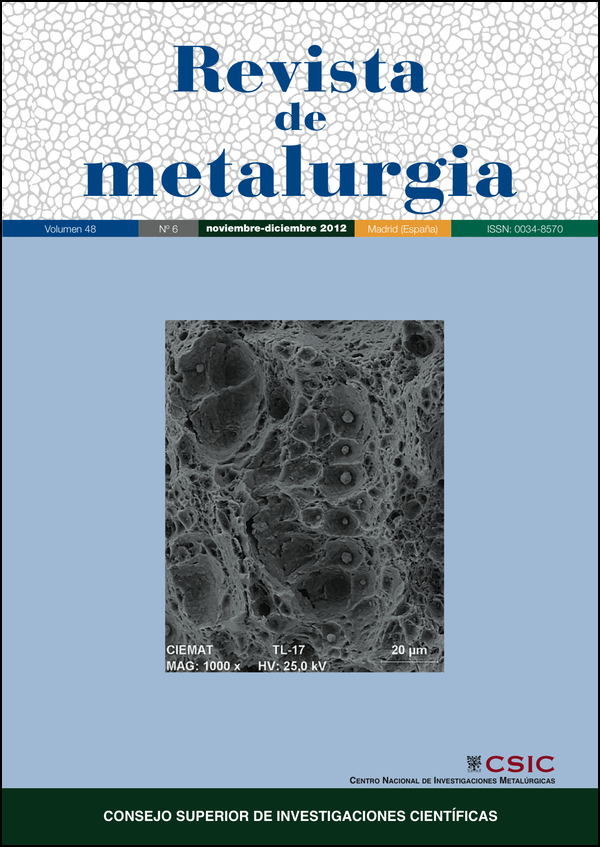Corrosion behavior of Fe3Al intermetallics with addition of lithium, cerium and nickel in 2.5 % SO2+N2 at 900 °C
DOI:
https://doi.org/10.3989/revmetalm.1149Keywords:
Iron aluminides, Alloy addition, High temperature corrosion, Oxide scale, Oxide/Alloy interfaceAbstract
The corrosion behavior of Fe3Al-type intermetallic alloys with addition of 1 at. % cerium, lithium and nickel at high temperature has been studied. The various alloys were exposed to an environment composed of 2.5 % SO2+N2 at 900 °C for 48 h. For all the intermetallic tested, the corrosion kinetics showed a parabolic behavior. The alloy, which showed less corrosion rate, was the Fe3AlNi alloy, being Fe3AlCeLi the alloy with the highest corrosion rate. For the various alloys, energy dispersive X-ray spectroscopy analysis, EDS, on the developed scale only detected aluminum, oxygen, and traces of iron and cerium, suggesting the formation of alumina as main component. The intermetallic alloys showed oxide cracking and spalling. The intermetallic chemical composition played an important role in defining the oxide scale morphology and the extent of damage.
Downloads
References
[1] Metals Handbook Ninth Edition, Vol . 13, Corrosion, High-Temperature Corrosion in Gases, ASM International, 1987, p. 97.
[2] C. G. McKamey, J. H. Devan, P. F. Tortorelli and V. K. Sikka, J. Mater. Res. 6 (1991) 1779-1805. http://dx.doi.org/10.1557/JMR.1991.1779
[3] V. K. Sikka, C.G. McKamey, C.R. Howell and R. H. Baldwin, Fabrication and Mechanical Properties of Fe 3Al -Based Aluminides, ORNLRTM-11465, Oak Ridge National Laboratory, Oak Ridge, TN, 1990. http://dx.doi.org/10.2172/6596000 PMCid:1792270
[4] K. Natesan and P.F. Tortorelli, Proc. Int. Symp. on Nickel and Iron Alumin ides Processing, Properties, and Applications, Cincinnati, OH, 1996, ASM International, Materials Park, OH, 1997, pp. 265-287.
[5] J.H. Devan, H.S. Hsu and M. Howell, ORNL, report TM-11176, Oak Ridge, TN, 1989.
[6] K. Natesan, Mater. High Temp.14 (1997) 71-79.
[7] K. N. Strafford and R. Manifold, Oxid. Met. 5 (1972) 85-112. http://dx.doi.org/10.1007/BF00610839
[8] P. C. Patnaik an d W.W. Sm eltzer, Oxid. Met. 23 (1985) 53-75. http://dx.doi.org/10.1007/BF01095807
[9] P. J. Smith and W.W. Smeltzer, Oxid. Met. 28 (1987) 291-297. http://dx.doi.org/10.1007/BF00666724
[10] S. Mrow ec, Oxid. Met. 44 (1995) 177-209. http://dx.doi.org/10.1007/BF01046727
[11] P.C. Patnaik and W.W. Smeltzer, J. Electrochem. Soc. 132 (1985) 1226-1232. http://dx.doi.org/10.1149/1.2114073
[12] V. L. Hill and H. S. Mayer, High Temperature Corrosion in Energy Systems, Edby M. F. Rothman. The Metallurgical Society of the AIME,1985, pp. 29-52.
[13] P. F. Tortorelli and K. Natesan, Mater. Sci. Eng. A 258 (1998) 115-125. http://dx.doi.org/10.1016/S0921-5093(98)00924-1
[14] K. Natesan and R. N. Johnson, Proceedings of the 2nd International Conf. on Heat-Resistant Materials, K. Natesan, P. Ganesan, G. Lai (Eds.) Gatlinburg, Tennessee, 1995, pp. 591-600.
[15] P. F. Tortorelli and J.H. Devan, Chapter 3 in: G. Welsch, P. D. Desai (Eds.), Oxidation and Corrosión of Intermetallic Alloys, Metals Information Analysis Center, Purdue University, West Lafayettem, IN, 1996. PMid:8661903
[16] P. F. Tortorelli and P. S. Bishop, Environmental Effects on Advanced Materials, R.H. Jhones and R.E. Ricker (Eds.), The Minerals, Metals and Materials Society, Warrendale, P.A., 1991, p. 91.
[17] M. Salazar, A. Albiter, G. Rosas and R. Pérez, Mater. Sci. Eng. A 351 (2003) 154-159. http://dx.doi.org/10.1016/S0921-5093(02)00825-0
[18] P. F. Tortorelli and J. H. Devan, Mater. Sci. Eng. A 153 (1992) 573-577. http://dx.doi.org/10.1016/0921-5093(92)90253-W
[19] W. Kai , S. H. Lee, D. L. Chiang and J. P. Chu, Mater. Sci. Eng. A 258 (1998) 146-152. http://dx.doi.org/10.1016/S0921-5093(98)00927-7
[20] W. Kai, M.T. Chang, C.D. Liu, D.L. Chiang and J. P. Chu, Mater. Sci. Eng. A 329-331 (2002) 734-744. http://dx.doi.org/10.1016/S0921-5093(01)01519-2
[21] W. Kai and R.T. Huang, Oxid. Met. (1997) 48-59.
[22] W. Kai, J. P. Chu, R. T. Huang and P. Y. Lee, Mater. Sci. Eng. A 239-240 (1997) 859-870. http://dx.doi.org/10.1016/S0921-5093(97)00676-X
[23] F.H. Stott, K.T. Chuah and L. B. Bradley, Oxidation of Intermetallics, Eds. H. J. Grabke, M. Schutze, 1997, pp. 221-232. http://dx.doi.org/10.1002/9783527612413.ch14
[24] K. Natesan, Mater. Sci. Eng. A 258 (1998) 126-134. http://dx.doi.org/10.1016/S0921-5093(98)00925-3
[25] J. H. Devan and P. F. Tortorelli, Corros. Sci. 35 (1993) 1065-1071. http://dx.doi.org/10.1016/0010-938X(93)90325-B
[26] J. J. Ramos-Hernández, Tesis de Maestría, Facultad de Química-UNAM, 2009.
[27] K. Natesan, Prepared for Environmental Degradations of High-Temperature Materials, ANL, Argonne, Illinois, 1980, pp. 60-69.
[28] A.K. Misra, Thermodynamic Analysis of Compatibility of Several Reinforcement Materials With FeAl Alloys. NASA Contractor Report 4172, 1988.
[29] INS NIST-JANAF Thermochemical Tables, Fourth Edition, National Institute of Standards and Technology, 1998.
[30] D.P. Whittle, High Temp. Corros. Ed. R. A. Rapp, NACE-6, Houston,1981.
[31] W. H. Lee and R. Y. Lin, Mater. Chem. Phys. 58 (1999) 231-242. http://dx.doi.org/10.1016/S0254-0584(98)00280-6
[32] D. Monceau and B. Pieraggi, Oxid. Met. 50 (1998) 477-493. http://dx.doi.org/10.1023/A:1018860909826
[33] P.L. Hemmings and R. A. Perkins, FP-539 Research Project 716-1. Prepared by EPRI, Palo Alto Cal. Dec. 1977.
[34] K. Natesan, K. Klug, D. Renusgh, B. W. Veal and M. Grimsditch, ANL/FE-96/01, pp. 1-20.
[35] B. A. Pint, Mater. Sci. Forum. 369-372 (2001) 411-418. http://dx.doi.org/10.4028/www.scientific.net/MSF.369-372.411
[36] M. A. Montealegre and J. L. González-Carrasco, Intermetallics 11 (2003) 169-175. http://dx.doi.org/10.1016/S0966-9795(02)00211-X
[37] D.B. Lee, G. Y. Kim and J. G. Kim, Mater. Sci. Eng. A 339 (2003) 109-114. http://dx.doi.org/10.1016/S0921-5093(02)00112-0
[38] M.W. Brumm and H. Grabke, J. Corros. Sci. 33 (1992) 1667-1675. http://dx.doi.org/10.1016/0010-938X(92)90002-K
[39] P.F. Tortorelli and J. H. Devan, Oxidation and Corrosion of Intermetallic Alloys, Chapter 3. Ed. Welsh and P. D. Desai, 1996, pp. 266-321.
Downloads
Published
How to Cite
Issue
Section
License
Copyright (c) 2012 Consejo Superior de Investigaciones Científicas (CSIC)

This work is licensed under a Creative Commons Attribution 4.0 International License.
© CSIC. Manuscripts published in both the printed and online versions of this Journal are the property of Consejo Superior de Investigaciones Científicas, and quoting this source is a requirement for any partial or full reproduction.
All contents of this electronic edition, except where otherwise noted, are distributed under a “Creative Commons Attribution 4.0 International” (CC BY 4.0) License. You may read the basic information and the legal text of the license. The indication of the CC BY 4.0 License must be expressly stated in this way when necessary.
Self-archiving in repositories, personal webpages or similar, of any version other than the published by the Editor, is not allowed.
















